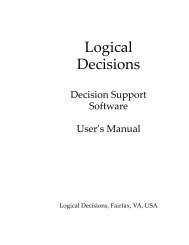AFTER VIOLENCE: 3R, RECONSTRUCTION, RECONCILIATION ...
AFTER VIOLENCE: 3R, RECONSTRUCTION, RECONCILIATION ...
AFTER VIOLENCE: 3R, RECONSTRUCTION, RECONCILIATION ...
Create successful ePaper yourself
Turn your PDF publications into a flip-book with our unique Google optimized e-Paper software.
ecoming a permanent state of society. A society can also become<br />
nonviolence-torn.<br />
In short, the conditions are similar to the conditions for<br />
using violence: the suffering is intolerable, all nonviolent means<br />
have already been tried, the violence is minimal and it is not<br />
glorified afterwards, for instance as hero worship./92/<br />
10. Reconstruction/Reconciliation/Resolution: The interface<br />
To repeat: the enormous complexity of problems, dangers and<br />
opportunities that emerge from violence in general, and war in<br />
particular, has been reduced to three components: reconstruction<br />
(after the violence), reconciliation (of the parties) and then<br />
more than ever: resolution (of the underlying conflict). Each one<br />
is a universe in its own right with its own complexity.<br />
How do the three relate to each other? The interface must be<br />
rich if for no other reason simply because dramatis personae are<br />
the same, at least as far as perpetrator and victims are concerned<br />
(a distinction more or less superseded in Buddhism through the<br />
karma concept). The two meet each other as perpetrator and victim<br />
in the violence relation (which is already emphasized in the title<br />
of this manual) possibly with a shared interest in reconstruction.<br />
As human beings, naked, vulnerable, individually or collectively<br />
organized, they may be in search of reconciliation. And they have<br />
incompatible goals (values/interests) in a conflict formation that<br />
may have survived it all without coming anywhere nearer its<br />
resolution.<br />
For them the three sets of roles and stages blend into one.<br />
It is impossible to say where one ends and the other starts. The<br />
analytical distinctions made here are made from above by one more<br />
100
















